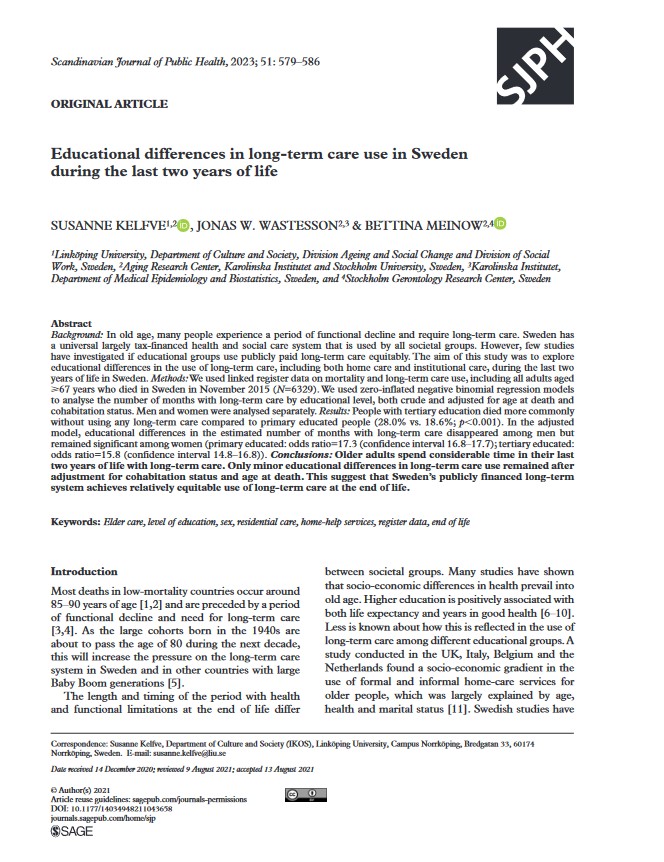Användningen av långtidsvård i förhållande till utbildningsnivå
 In old age, many people experience a period of functional decline and require long-term care. Sweden has a universal largely tax-financed health and social care system that is used by all societal groups. However, few studies have investigated if educational groups use publicly paid long-term care equitably. The aim of this study was to explore educational differences in the use of long-term care, including both home care and institutional care, during the last two years of life in Sweden. We used linked register data on mortality and long-term care use, including all adults aged ⩾67 years who died in Sweden in November 2015 (N=6329). We used zero-inflated negative binomial regression models to analyse the number of months with long-term care by educational level, both crude and adjusted for age at death and cohabitation status. Men and women were analysed separately. People with tertiary education died more commonly without using any long-term care compared to primary educated people (28.0% vs. 18.6%; p<0.001). In the adjusted model, educational differences in the estimated number of months with long-term care disappeared among men but remained significant among women (primary educated: odds ratio=17.3 (confidence interval 16.8–17.7); tertiary educated: odds ratio=15.8 (confidence interval 14.8–16.8)). Older adults spend considerable time in their last two years of life with long-term care. Only minor educational differences in long-term care use remained after adjustment for cohabitation status and age at death. This suggest that Sweden’s publicly financed long-term system achieves relatively equitable use of long-term care at the end of life.
In old age, many people experience a period of functional decline and require long-term care. Sweden has a universal largely tax-financed health and social care system that is used by all societal groups. However, few studies have investigated if educational groups use publicly paid long-term care equitably. The aim of this study was to explore educational differences in the use of long-term care, including both home care and institutional care, during the last two years of life in Sweden. We used linked register data on mortality and long-term care use, including all adults aged ⩾67 years who died in Sweden in November 2015 (N=6329). We used zero-inflated negative binomial regression models to analyse the number of months with long-term care by educational level, both crude and adjusted for age at death and cohabitation status. Men and women were analysed separately. People with tertiary education died more commonly without using any long-term care compared to primary educated people (28.0% vs. 18.6%; p<0.001). In the adjusted model, educational differences in the estimated number of months with long-term care disappeared among men but remained significant among women (primary educated: odds ratio=17.3 (confidence interval 16.8–17.7); tertiary educated: odds ratio=15.8 (confidence interval 14.8–16.8)). Older adults spend considerable time in their last two years of life with long-term care. Only minor educational differences in long-term care use remained after adjustment for cohabitation status and age at death. This suggest that Sweden’s publicly financed long-term system achieves relatively equitable use of long-term care at the end of life.
 In old age, many people experience a period of functional decline and require long-term care. Sweden has a universal largely tax-financed health and social care system that is used by all societal groups. However, few studies have investigated if educational groups use publicly paid long-term care equitably. The aim of this study was to explore educational differences in the use of long-term care, including both home care and institutional care, during the last two years of life in Sweden. We used linked register data on mortality and long-term care use, including all adults aged ⩾67 years who died in Sweden in November 2015 (N=6329). We used zero-inflated negative binomial regression models to analyse the number of months with long-term care by educational level, both crude and adjusted for age at death and cohabitation status. Men and women were analysed separately. People with tertiary education died more commonly without using any long-term care compared to primary educated people (28.0% vs. 18.6%; p<0.001). In the adjusted model, educational differences in the estimated number of months with long-term care disappeared among men but remained significant among women (primary educated: odds ratio=17.3 (confidence interval 16.8–17.7); tertiary educated: odds ratio=15.8 (confidence interval 14.8–16.8)). Older adults spend considerable time in their last two years of life with long-term care. Only minor educational differences in long-term care use remained after adjustment for cohabitation status and age at death. This suggest that Sweden’s publicly financed long-term system achieves relatively equitable use of long-term care at the end of life.
In old age, many people experience a period of functional decline and require long-term care. Sweden has a universal largely tax-financed health and social care system that is used by all societal groups. However, few studies have investigated if educational groups use publicly paid long-term care equitably. The aim of this study was to explore educational differences in the use of long-term care, including both home care and institutional care, during the last two years of life in Sweden. We used linked register data on mortality and long-term care use, including all adults aged ⩾67 years who died in Sweden in November 2015 (N=6329). We used zero-inflated negative binomial regression models to analyse the number of months with long-term care by educational level, both crude and adjusted for age at death and cohabitation status. Men and women were analysed separately. People with tertiary education died more commonly without using any long-term care compared to primary educated people (28.0% vs. 18.6%; p<0.001). In the adjusted model, educational differences in the estimated number of months with long-term care disappeared among men but remained significant among women (primary educated: odds ratio=17.3 (confidence interval 16.8–17.7); tertiary educated: odds ratio=15.8 (confidence interval 14.8–16.8)). Older adults spend considerable time in their last two years of life with long-term care. Only minor educational differences in long-term care use remained after adjustment for cohabitation status and age at death. This suggest that Sweden’s publicly financed long-term system achieves relatively equitable use of long-term care at the end of life.



